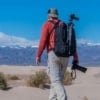Foy is right on when he says early geology experiences influence our recreation for the rest of our lives.
When I consider the experience I rely on and gear used for remote camping, even with a four-wheel popup and a 4WD vehicle, it is remarkable how much of what I carry and use regularly has direct links to my geology education and experience many years ago. A partial list:
- I always have a rock hammer, a gad, an estwing miner's pick, brunton compass and several types of hand lens.
- Cameras and various lenses.
- Maps, maps and more maps -- with a knowledge of how to use them.
- Geology reference books for the areas we visit. It is amazing how often geology books go hand in hand with hiking and backcountry access guides.
- Good boots, including a spare pair, sturdy clothes, a good sun hat, and a great pack, with food, water and first aid kit, for day hikes.
- Gloves of various kinds. For various purposes I use leather with Kevlar lining gloves, nomex gloves, mechanic's' gloves, electronic device compatible gloves and latex gloves.
- Good wrap around sunglasses that do not change the color cast of what I am looking at.
- Lots of different flashlights. Spare batteries in abundance.
- Reliable vehicle repair tools and supplies.
- Outdoor cooking gear. We almost never cook in the camper, preferring to use a propane cook stove outside. Same with coffee making -- I use a Jetboil for pour over outside every morning. (I have some colorful memories about dining experiences while on geology field trips. Results in both lowered and raised expectations!)
- Most importantly, a feel for the terrain and the terrane, and how wind, rain and other weather can change on the ground conditions.
I highly recommend a geology education for anyone that wants to spend much of their life outdoors, as well as for those of us that dreamed of doing so while desk-bound for decades.
Edited by AWG_Pics, 09 May 2022 - 02:55 PM.














